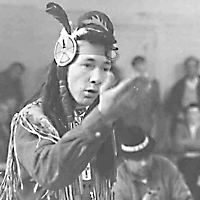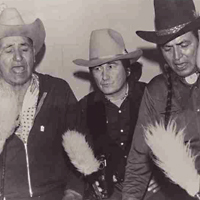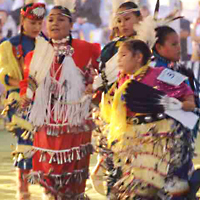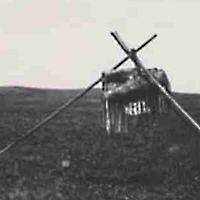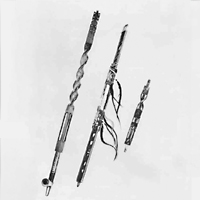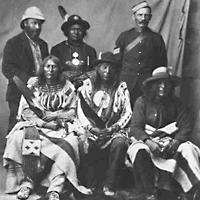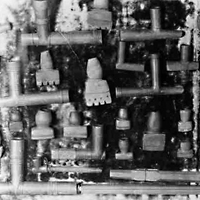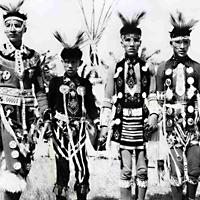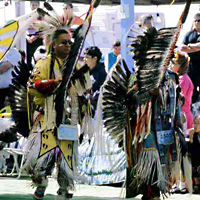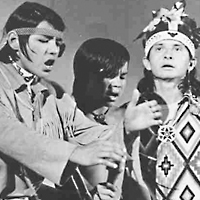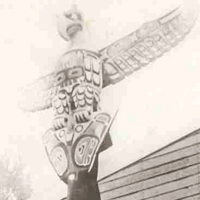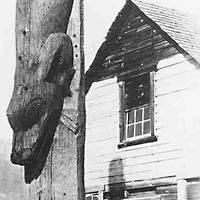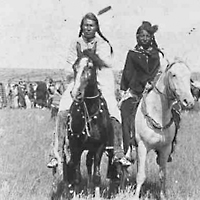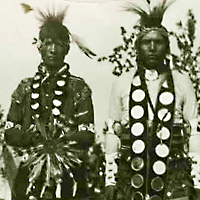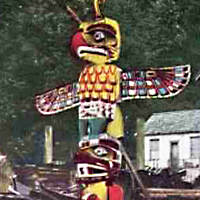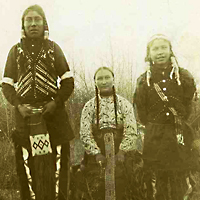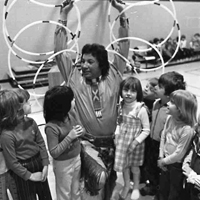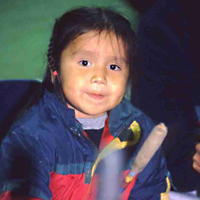The Changing Relationship between First Nations Peoples and Museums
Author: Meagan Gough
Humans have both an inquisitive and acquisitive nature. Historically, it has been these qualities of our nature most poignantly represented within museums. However, currently the return or "repatriation" of First Nation’s cultural property in Canada from museums back to their communities of origin is of significant social, cultural and political interest to Aboriginal Peoples. Repatriation is a process that is complex and continually changing, so we must first start by exploring what influences the possibilities and limitations of repatriating cultural property.
To this end, the following questions need to be answered: what information do First Nations individuals and communities need to successfully participate in this process? There has been a dramatic shift in the last 15 years regarding explicit moral and ethical consequences of repatriation for First Nations and museums regarding the museum’s management of cultural property by museums. The implicit complexity involved in the reality of the process is apparent, and serves to illuminate a site of cultural politics. A synthesis of the vast amount of information that informs repatriation, including contemporary guidelines and ad hoc policies is potentially informative to communities intending to repatriate. How does a community initiate the return of their sacred objects? What are the possibilities? What are the limitations? What information is relevant and useful? Who do I speak with?
A discussion of these issues has been limited here in order to manage a topic which is extremely complex. Here, we will explore the process of repatriation specifically in relation to the dissemination of knowledge required to properly inform a community of the possibilities of repatriation. There are numerous other issues involved in the practical aspects of repatriation once objects have been located within museums. A sampling of issues that arise once the process has been initiated include: the accessibility of funding required by communities to visit museums and verify objects’ "authenticity"; the determination and implementation of culturally appropriate means of handling, storing and identifying objects on behalf of cultural institutions; the use of chemicals to treat objects within museums and the potential threat this poses to communities planning to put them back into use once repatriated; and finally, the complex issue of cultural affiliation.
In order to contextualize this discussion of the repatriation process, it is useful to examine the meaning and implications of the terms "cultural property" and "repatriation" within contemporary discourse. A brief historiographical sketch illustrates how changing definitions influence contemporary museum legislation and policy.
Prior to the 1970’s, First Nation’s cultural property as a social construct largely related to material culture of a cultural "other" considered distinct from the Western world. Anthropologist and museum expert James Nason articulates the development of the concept of cultural property as the following: "The contemporary battle over the control of this significant heritage of (Native American) cultural property began in earnest in the 1960’s within an international context of massive looting of archeological sites, widespread museum and heritage centre thefts, and associated smuggling and other illicit transfers of cultural property from their places of origin. Scholarly outrage and general public concern with these matters grew as information about the sheer magnitude of these abuses became more and more apparent1 As a result of this alarming situation, the 1970 UNESCO Convention on the Means of Prohibiting and Preventing the Illicit Import, Export and Transfer of Ownership of Cultural Property was held. "The convention did more centrally establish for the first time international guidelines that cultural property of all kinds should be protected by all Nations and should be the subject of repatriation when illicitly removed."2 Simultaneously, the Convention generated a new definition of cultural property. The Convention’s definition encompassed as cultural property all possible objects of importance to archeology, anthropology, history, literature, art, or science, including fauna, flora, minerals, paleontology, monuments or parts of archeological sites, antiquities, all types of artworks, incunabula, documents, stamps of all sorts, furniture and musical instruments, and all archival materials. Nason notes that "Of special interest here is the inclusion in the last category of documents, books and photographic, cinematographic, and sound recordings, all key forms of what has become known as intellectual property."3 For the purposes of a contemporary discussion related to repatriation, a broad definition of cultural property is useful, and provides insight into the range of possibilities relating to repatriation efforts.
What emerged in the late 70’s and 80’s was a shift to include "intangible cultural property" in discussions related to repatriation. "Intangible cultural property" is defined as "broadly based, and ranges from concerns about the maintenance of traditional languages, to concerns about traditional religious lore and practices, traditional and detailed knowledge of the natural world, and all types of oral history, oral literature and other knowledge that could generally be referred to as ‘lore’."4
It is also noted by James Nason in the article "Native American Cultural Property Rights" that "Whatever form it takes, such specialized knowledge is characteristically regarded as property within tribal legal systems and therefore constitutes a key form of traditionally defined intellectual property."5
The value of such "intangible" forms of cultural property is expressed by Athabaskan Elder Angela Sidney’s comments on the wealth of her oral tradition, a form of intangible property to her: "I have no money to leave my grandchildren. My stories are my wealth".6
The specific incidence of the removal or "appropriation" of intangible cultural knowledge, (or what is often now referred to as intellectual property) as a component of the larger appropriation of Aboriginal material culture is an important ethical consideration for scholars and those who work with Aboriginal communities. These "intangible" forms of cultural property are considered of special or sacred importance to Aboriginal communities, and have been acquired both knowingly and unknowingly by researchers and scholars.7 This knowledge, including oral history, tradition, language of origin, song, knowledge of natural features and ceremonial practices is represented in various contemporary repatriation efforts, and illuminates the need to examine the discursive categories that have historically defined ‘culture’.
The concept of repatriation similarly developed into a component of the contemporary discourse in the eighties and nineties. In Canada, there was a series of historical events that generated awareness of the process. It is important to consider the developments of this historical climate and dominant narrative in order to contextualize the contemporary debate.
A major catalyst for reflection on issues of Aboriginal representation and management of cultural property was provided by the 1988 Calgary Olympics as a result of the Spirit Sings exhibit put on at the Glenbow Museum in Calgary. The Lubicon Lake Cree of Northern Alberta, who protested the exhibit, claimed both political and ethical reasons for their reactions. Members of the Lubicon community decided to boycott the exhibit partially because it was sponsored by Shell Oil, who was drilling in the area claimed by the Lubicons’ as their traditional land.8 Aside from the political and economic reasons the community had for their protest, "it was assumed that The Spirit Sings only pertained to the Native peoples of the past",9 and the community asserted that confining images of "Indianness" to an ethnographic past while overwriting contemporary social and economic issues which their community faced was morally and ethically objectionable. The protests raised questions within the academic and museum communities as well as the public such as "who owns the past?" and "how do notions of ‘authentic’ Aboriginal culture manifest themselves within museums?", which commenced a dialogue that reflected on representations of Aboriginal communities, management of cultural and intellectual property and the repatriation of such knowledge that continues today.
As a result of the Spirit Sings10 and the ethical and epistemological issues raised by it, the Canadian Museums Association (CMA) Taskforce on First Peoples was organized by the CMA and the Assembly of First Nations in 1990. The Taskforce attempted to, as outlined in its mission statement "…develop an ethical framework and strategies for Aboriginal Nations to represent their history and culture in concert with cultural institutions."11 The Taskforce, which had an unprecedented number of scholars and Aboriginal people as participants sought to provide guidelines for relationships between museums and First Peoples that would be less problematic, and this simultaneously brought the concepts of repatriation into a National dialogue for the first time in Canada.12
Contemporary repatriation efforts within Canada are largely guided by various informal or "ad hoc" policies, but are influenced by American legislation as well. While keeping in mind a broad definition of cultural property, a synthesis of relevant policies and legislation is at this point useful. In the United States, the implementation of the Native American Graves Protection and Repatriation Act (NAGPRA), Federal legislation passed in 1990, affects all contemporary repatriation efforts. NAGPRA is relevant to Canadian First Nations repatriation efforts when objects are located in American museums. Notably, NAGPRA’s working definition of cultural property, or objects that fall under its control, is much more narrow than is the contemporary abovementioned definition, which also includes intangible forms that are often also kept in museums as a result of being acquired by scholars as descriptive forms of the objects collected. NAGPRA deals with the ownership and control over Native American "cultural items", which are defined as the following within the legal parameters of the NAGPRA legislation: "human remains, associated and unassociated funerary objects, sacred objects and objects of cultural patrimony."13 Through the application of this definition of cultural property, NAGPRA focuses on the following: the establishment of procedures and legal standards for the repatriation of human remains, funerary objects, sacred objects and cultural patrimony by federal agencies and certain museums, educational and other institutions and local governments; as well as the recognition of tribal and Native Hawaiian and individual rights in regard to burial sites located on federal and tribal lands.
Also characteristic of NAGPRA is that it only relates to the repatriation of cultural property within the public realm and does not address repatriation within the private sector, which includes auction houses and private collectors. Within Canada, there is no comparable Federal legislation such as NAGPRA, and therefore repatriation efforts are subject to the discretion of museum directors and the protocol established by various ad hoc museum polices and treaty precedents.
In 1990, the CMA Taskforce concluded that it was more relevant to handle repatriation efforts on a case by case basis. Although this method has been the subject of much debate among scholars and First Nations, the following are some of the major policy developments that inform the process itself.
The 1990 CMA Taskforce had a major impact on the relationships between museums and First Peoples and subsequently, repatriation. If not in a purely pragmatic sense, a definite ideological shift was a result of the symposium, which has had an impact on the considerations that museum personnel are willing to make for contemporary repatriation efforts. The principles and strategies outlined in the Taskforce are considered useful and relevant to contextualizing repatriation in Canada.
Individual museums have developed their own policies to address the issue of repatriation, and one of the concerns about having "ad hoc" policies instead of enacted legislation is that there may be large discrepancies in how the museum will approach repatriation. This is evident in how various museums provide access to resources needed by communities to repatriate.
The Museum of Anthropology (MOA) in Vancouver serves as an excellent example of providing useful and accessible information to communities intending to repatriate. On the museums website14 the following useful information can be found: guidelines for repatriation and the management of cultural property within the museum; information regarding how to make a claim for an object or file a request for information regarding the location of an object both within the museum and in international and American collections; how to request information relating to a specific object known to be in the collection for example, when it was acquired and its current condition. A prototype of a request letter is also provided in an effort to clearly illustrate the information a community is required to provide. The prototype simultaneously functions to make the application process easier for people and communities who may not be familiar with formal museum protocol or dealing with institutional practices. The webpage also provides links and contacts to museum personnel, as well as specific names of contacts at various international and U.S. museums.
In terms of availability of necessary information, the MOA did an excellent job at making the required information accessible. By considering the diverse local needs and circumstances of the Aboriginal communities the information is intended for, the MOA illustrates how both the medium and the message are intrinsically linked to informing the possibility of repatriation.
The dissemination of knowledge on behalf of other museums can be found to be very problematic, and illustrates the limitations that communities face while engaging in this process. Such limitations are inherently political, and are articulated in anthropologist Adrian Tanner’s notion of ‘symbolic politics’. Symbolic politics, claims Tanner, "…involve demands made by Indians - demands which the Government does not, or cannot understand or respond to, and to which it only replies with offers of items other than those being demanded...Since it is clear to the Indians themselves that their demands are not actually up for negotiation."15 A second kind of politics that emerges between Indians and the State "pertains to an Indian group’s negotiation and attempts to make gains, but within the dominant society’s own formulation of an issue."16
These politics, which can be easily observed in the failure to provide access to necessary information to participate in repatriation, constitute "sites of cultural politics", which are a result, Tanner argues, of how Aboriginal people are situated within dominant cultural and social systems. He notes: "Indians constitute a political minority which is largely external to the normal political system, and does not have the same notions about the legitimacy of the state."17
As a result of such politics, privately funded organizations have been working to develop a better means of participating in repatriation by developing tools to gain the information required. One notable example is the American Indian Ritual Object Repatriation Foundation (AIORF). AIORF is a foundation created to help facilitate and educate communities and collectors about the repatriation process in the United States. The organization provides information resources to communities intending to repatriate both public and private collections. As mentioned earlier, private collections are not subject to the NAGPRA law, and AIORF aims to monitor the transfer of cultural property in this sphere. AIORF’s publication Mending the Circle: A Native American Repatriation Guide, which is "designed to aid the reader in seeking the repatriation of specific items,"18 is one of the most comprehensive information packages available relating to issues and questions about repatriation.
The information guide is designed to inform Aboriginal communities about the process of repatriation and about the status of the museum or institution currently in possession of the material, while simultaneously providing the parameters of repatriation efforts related to "institutions and individuals that do not receive Federal funds and are therefore defined as the ‘Private Sector."19
The work of AIORF and others represent a growing self-initiated attitude among stakeholders in the repatriation process who have found the institutional channels either dissatisfactory or overly consuming in terms of time, expertise and financial resources.
In order to fully demonstrate both the limitations and issues that are potentially faced by communities and individuals engaging in the process of repatriation, a social, historical, political, epistemological and cultural context must be presented. In addition to the previous discussion, it is essential to critically examine museum policy and practice, local First Nations perspectives of such practices, and certain related anthropological themes.
Following are what I have defined as key sites of cultural politics related to repatriation and pertain to areas that are currently or have been historically problematic to the development of effective policies with relation to cultural property management. The following categories; appropriation, ownership, representation, authenticity and voice are a reflection of the contemporary discourse as it relates to the relationship between museums and First Peoples.
Appropriation, which is defined as the means by which objects were acquired, should be examined in both legal and ethical terms, as it defines some of the parameters of contemporary repatriation efforts. The means by which an object was appropriated necessarily impacts the mode and possibilities of repatriation. In Canada, as occurred elsewhere for Aboriginal peoples, the last 120 years has been characterized by an unprecedented amount of collecting involving "cultural property", including what have been previously defined as "intangible" forms.
To put the magnitude of such collecting in perspective, James Nason notes, "Native Americans are among the most, if not the most, studied people in the history in the modern world."20 Such collecting was particularly rampant on the Northwest Coast at the turn of the century when "ethnographers, museum curators and anthropologists suddenly discovered the art of the northwest coast." Specifically, "the period from 1880-1900, collectors combed the region in what has been described as a ‘collecting rampage’."21 The excessiveness of this era is exemplified by the following scenario: "In 1897, an Anglican clergyman at the Masset complained in a letter to the newspaper that ‘every (Native) grave has been rifled and the boxes that contained the bodies left strewn about’. It is said that by 1910, most traditional objects of value, including totem poles had been removed. The Natives had been divested of almost every traditional object that they owned."22
Anthropologists at this time, working within the salvage paradigm of anthropology, moved towards cultural property with a sense of urgency. As has been the dominant narrative for the majority of the past century, the widespread ideology was that Native people were disappearing. As Adolf Bastian reflected "What can be done must be done now. If it is not, the possibility of ethnology is forever lost."23 The notion of both a moral and scientific mission permeated collecting in the late 19th and early 20th century and raises valuable ethical considerations in a contemporary repatriation debate. Franz Boas’s reflections at a potlatch feast in Fort Rupert in 1930 foreshadowed the contemporary implications of the mass appropriation of cultural property: The host chief, Boas wrote, made a speech while the meat was distributed, saying: ‘This bowl in the shape of a bear is for you’, and you, and so on; for each group a bowl." The speech was the same one that he had heard often before, as he noted: "But the bowls are no longer there. They are in museums in New York and Berlin!’"24
Although many objects of cultural significance were appropriated through "legal" means, the illegal appropriation of objects has also clearly occurred and may be illustrated through the Kwakuitl 25 potlatch collection. What is distinguishable about the potlatch collection is that "Unlike other cases of objects appropriated by scholars, missionaries or traders, the "potlatch collection" as it is now known was acquired by the Federal Government of Canada as a result of the 1885 amended Indian Act which outlawed Native participation in the potlatch."26 This amendment to the Indian Act also restricted Plains people’s participation in the spiritually and culturally significant Sundance ceremony.
As a result, "Indian Agent William Halliday, in Dec. 1921, was able to obtain 45 convictions. With 3 on appeal, 20 individuals, (including ranking chiefs and women) went to prison. However, 22 received suspended sentences in return for agreeing to hand over their potlatch regalia. A total of 750 objects were turned in, for which the Government gave the Natives collectively $1, 495."27 Anthropologist Ira Jacknis notes that "the Kwakuitl never forgot the 1922 "confiscation", but until the Anti-Potlatch Law was dropped in 1951, there was little they could do".28 The historical circumstances surrounding the appropriation of the Kwakwaka’wakw ‘potlatch collection’ influenced both the form and meaning that future repatriation efforts would take within the community. The first recorded efforts to have the so called ‘potlatch collection’ returned date from 1958.29 The Kwakuitl, in anticipation and preparation for the hopeful return of the collections, successfully sought out and acquired funds for two cultural centers in which to house the collections during the 1970’s.30 In 1992, 70 years after the initial confiscation, the National Museum of the American Indian (NMAI) returned 9 of the objects to the community. 31 Efforts are still ongoing, and most recently masks have been located at the British Royal Museum in England, who are currently refusing the return of the masks. The repatriation of the "potlatch collection" has been interpreted by Ira Jacknis to exist as an ongoing social drama in addition to the return of the objects themselves. Drawing upon anthropologist Victor Turner’s model of the 4 phases of social drama: (breech, crisis, redressive action and reintegration), Jacknis reflects that "For the Kwakuitl, the events of 1922 have become a central point of reference in the definition of themselves and their relation to the dominant society. The confiscation marks a time of oppression and forced culture change, and the outcome of the drama, the return of the artifacts, symbolizes their new relationship with white society."32
The historical facts of the appropriation of the potlatch collection clearly influenced the mode and form of repatriation and served to illuminate the Kwakuitl communities’ history, so that in essence the return of the objects symbolically marked the return and reintegration of their history and survival as a community.
A discussion of appropriation necessarily leads towards an examination of ownership within the context of cultural property. How do museums define ownership? How do these definitions vary cross-culturally? As Aboriginal Scholar Deborah Doxtater notes, "In the past, most of the debate concerning ownership of aboriginal cultural property has focused on the distinction between "moral" and "legal" ownership and she asserts that "museums are quick to point out that the vast majority of their collections were acquired through legal transactions made voluntarily by aboriginal people, and that, were it not for museum collections, the objects and collected information might not have survived for the potential use of Aboriginal people at all."33 And yet, regardless of the means by which the objects were acquired, the fundamental and defining aspect of this debate is that there are two very distinct cultural systems and ideologies present, illustrated by the belief that, as Doxtater claims: "For Aboriginal people, culture encompasses much more than the objects, but the objects cannot easily be separated by the culture, which includes the languages, beliefs and objects. In Euro-Canadian terms, people ‘own’ their heritage. In Aboriginal terms, the culture ‘owns’ the people."34 The idea of nationalism plays a part in how Canada as a Nation, and subsequently museums, have defined the role and purpose of Aboriginal people, culture and knowledge. Doxtater relates these notions of nationalism to a museum setting: "Moral ownership, of which the museum claims a kind, (the responsibility to the public)…is a result of Canadian nationalism exerted since the 19th century over peoples with whom Canada had made nation to nation treaties."35 These conflicting ideas of ownership and priorities amongst the key stakeholders in a museum setting (First Nations and the museum or institution) are very problematic, and have serious implications for Aboriginal communities. In respect to repatriation efforts met with resistance on behalf of museums, Doxtater asks of the public: "Is your enlightenment a priority over the communities to which these objects belong?"36 Similarly, Michael Ames, Canadian anthropologist and former Director of the MOA, relates the potential to engage with cultural knowledge and history to an underlying power dynamic that is characteristic of Aboriginal relations with museums when he notes: "Since those who control history benefit from it, people have a right to the facts of their own lives."37
In conclusion regarding the importance of ownership to Aboriginal communities, Doxtater reiterates the connection between knowledge, history and identity: "It’s a human responsibility. Everyone has to own who they are. You have to own who you are because if you don’t take responsibility, somebody else will, and when that happens, you end up having to live within the confines of what other people think your life should be."38
Ownership defined exclusively in legal terms is limiting to the development of a genuine and effective understanding of Aboriginal cultural property as it relates to repatriation efforts.
Issues of representation have become a focal point in the discussion between museums and First Nations. Historically, the representation of Aboriginal people within a museum setting has been marked by little collaboration and involvement by Aboriginal people. As outlined in the CMA Taskforce, one of the most valuable components of developing improved relations is for Aboriginal people to be able to represent themselves and their own histories. There are two essential aspects of the notion of representation that are being addressed in the contemporary discourse on the topic.
The first is an ideological shift that has occurred in the last 15 years within the scholarly community that moves toward attempts to employ reflexivity within a museum setting so as to situate Aboriginal culture and property within a more holistic context; one that includes the social, historical and political context that it exists within.
The second involves a pragmatic or applied shift towards increased participation by First Nations to create their own representation and simultaneously engage with their own culture and history on a deep and meaningful level. The related concept of self representation, linked to self determination and notions of cultural autonomy permeates all forms of the contemporary dialogue, or narrative between First Nations and greater Canadian society, and has been a major focus in developing improved relations between museums and First Peoples. How museums represent First Nations cultures, or more fundamentally that they embody this responsibility, highlights the heart of the contemporary ethical and political debate. The questions are not new, as illustrated by Boas’s early reflections that: "The character of an ethnological phenomenon is not expressed by its appearance, by the state which it is, but by its whole history."39 But the solutions are more holistic within a contemporary context. Increased pressure by First Nations peoples for more inclusiveness of their voice within their own cultural representations has been a catalyst for museum personnel and scholars to reflect on the "construction of representation." The introduction of reflexivity on behalf of anthropologists and museums with regard to how culture is represented and interpreted is apparent as a component of the post modern shift in anthropology in the late eighties and nineties. A host of scholars have contributed to a re-assessment of the means by which the cultural ‘other’ is represented. Anthropologists Jacknis and Dominguez advocate that one way to remedy such misrepresentations of culture within a museum setting is that scholars and the museum going public "not limit themselves to studying the first or original meaning of objects (that is, to the makers or original users) or to spending all their energies on attempts to reconstruct that early meaning." 40 Rather, these scholars and others suggest looking at the social, political and cultural "life" of the objects while they are in museums – the history of their removal, attempts to have them returned, and how they are classified and displayed – and what this teaches us about Western society.
Similarly, James Clifford’s art-culture system also advocates the inclusion of a cultural object’s social, political, historical and cultural meaning within museum exhibits, which is typically excluded in favor of an emphasis on aesthetic values or representations of primitivism. Clifford advocates that in this regard "it is important to resist the tendency of collections to be self sufficient, to suppress their own historical, economic and political processes of their own production. Ideally, the history of its own collection and display should be a visible aspect of any exhibit."41 One of the means by which representation is to be addressed within a museum setting is by attempting to situate the cultural object within the most holistic context possible, one which includes the political and social realities of its own existence and appropriation.
Authenticity is a related concept that emerges as a result of historical museum representations and changes within the narrative related to First Peoples. It is important to consider questions such as: what criteria have been historically implemented by both museums and the greater Canadian public to define "authentic" representations of Aboriginal culture(s) and, how have these categories and definitions impacted relationships between museums and First Peoples over time?
In Canada, challenges to socially and historically constructed ideas of what determined authentic Aboriginal culture began to arise in the late 1980’s when an ideological shift within academia and museums began to occur. Michael Ames reflects on this shift: "What is significant about the 1980’s is after 100 years and more of boxing others, museums (and their academic counterparts) are only now beginning to hear what the objects of classification, especially those same indigenous groups, have been saying all along: they want out of the boxes, they want their materials back, and they want control over their own history and its interpretation, whether the vehicles of expression be museums, exhibits, classroom discourses, or scholarly papers, textbooks and monographs. Since those who control history are the ones who benefit from it, people should have the right to the facts of their own lives."42
The Spirit Sings exhibit also had a profound impact on integrating notions of authenticity into contemporary discourse in Canada. The protests by the Lubicon Cree and numerous other Aboriginal people demanded that a paradigm shift occur, so that notions of Aboriginal culture(s) not be represented in an idyllic past. Joanne Cardinal Shubert, an Aboriginal artist who participated in the boycott relates why the protests were so meaningful: "We protested the fact that Native culture was being used by the Olympics to foster a worldview that Native culture was dead, all over, collected; and what was still practiced was frozen in the 18th century. We believe that the Olympics should have held exhibitions featuring contemporary Native art as it is now."43 Attempts continue to be made within a museum setting to challenge pre-existing and externally imposed constructions of authentic Aboriginal culture. The Fluff and Feathers: Exhibit on the Symbols of Indianness at the Woodland Cultural Centre provides an excellent example how a museum exhibit can challenge issues of representation, the construction of authentic Aboriginal identity as well as the appropriation of Aboriginal culture.
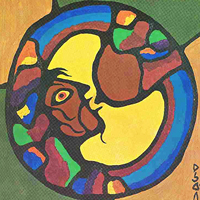 Contemporary Native Art of Canada - The Woodland Indians / Art Contemporain des Indiens Sylvicoles due Canada. - Booklet. - 1976 (image details) |
The foreword of the Guide to the exhibit, curated by Mohawk scholar Deborah Doxtater, addresses some of these issues: "When a society chooses its own symbols, it is a way of empowering itself and its individual members…what then happens to a culture whose symbols are chosen by outsiders, by those who do not understand its deepest beliefs, structures and ways of life?44 By utilizing a self reflective methodology intended to illuminate both the medium and the message, the exhibit successfully challenged and articulated the issues that form the contemporary discourse as it relates to First Nations peoples. The exhibit, which was risky yet thoughtful, provides an excellent example of the potential for museum exhibits to challenge misguided assumptions and stereotypes of Aboriginal people.
The related concept of "voice" has also developed as a part of the contemporary dialogue between First Nations and museums. The notion of "voice" manifests itself in numerous ways in this setting. In one sense, voice signifies a desire for increased participation, input and control for Aboriginal people to make decisions that affect their lives. In a more specific context, it questions whose voice is used in museum representations of Aboriginal culture(s), as is illustrated through the construction and writing of museum texts, as well as schematic and display techniques utilized by museums. In terms of epistemology, the notion of voice serves to challenge the social constructs that impose value and meaning on an Aboriginal voice as necessarily existing within an ethnographic and historical past. This is illustrated by an emphasis placed on "traditional forms" of Aboriginal culture within museums. Inherently, this "way of knowing" is very political in that it has functioned to encourage a view of Aboriginal cultures as static and unchanging. Michael Ames critiques the ideology present within museums as it relates to voice: "Museum exhibition techniques continue to impose moral and academic classifications - our ‘glass boxes’ of interpretation upon diverse cultures. The sizes and the shapes of these boxes have changed with the theoretical fashions of anthropology….they always remain anthropological boxes however, ‘freezing’ others into academic categories and into that mythical notion of time called the ‘ethnographic’ present."45 Efforts to integrate new forms of Aboriginal expression into a museum setting can be related to the notion of "innovative traditionalism", in which traditional forms of cultural expression are developed within contemporary indigenous cultures with their own creative roots and dynamics.
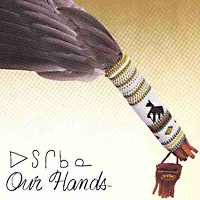 From Our Hands / an exhibition of native hand crafts - 12 November - 5 December 1982. - Program (image details) |
This reflects contemporary cultural politics and gives rise to a "traditionalism which is continually negotiated in the discourse and practice of everyday life."46 The fight to include a contemporary voice within the museum world was met with resistance in the early eighties, but the Fluff and Feathers exhibit signified the start of an ongoing series of questions and reflections that have characterized contemporary relations between First Nations peoples and museums.
The previous aspects of the relationship between museums and First Peoples, including appropriation, ownership, representation, authenticity and voice are valuable to understand, and through their integration into the contemporary dialogue are useful to continuing the development of fair and effective museum polices. Repatriation efforts cannot be separated from these issues; rather it is a reflection of them and needs to be perceived in this context. As demonstrated, the relationship between First Nations and museums is complex and informed by social, historical, political, cultural as well as epistemological influences.
There are no quick and easy resolutions to these issues, and yet there are some fundamental ideas and practices that will ideally be developed in the future. First, is the necessity for increased participation and input by Aboriginal people within the contemporary dialogue as well as a museum setting. This is both valuable and necessary in order to continue the development of satisfactory relationships. Second, the variance that occurs with regards to the dissemination of knowledge required for full participation on behalf of Aboriginal people must be challenged and rectified. While an explicit paradigm shift in an ideological sense has occurred, the implicit complexity apparent regarding the dissemination of knowledge is still problematic. If communities cannot access the information that they need to make informed choices about policies that affect their lives, such as those which inform repatriation, then they face many more limitations than they do possibilities.
Third, within academia as well as museums and other cultural institutions, continued reflexiveness and questioning as to how to conceptualize and handle cultural property is a valuable component to the ongoing relationships between museums and Aboriginal communities. As Michael Ames notes regarding the future of anthropology and museum studies, we must first start by critiquing our past, at which point we can construct a future filled with possibilities.47
Bibliography
American Indian Ritual Object Repatriation Foundation. (AIORF) Mending the Circle: A Native American Repatriation Guide. New York: AIORF Publications, 1996.
Ames, Michael. Cannibal Tours and Glass Boxes: The Anthropology of Museums. UBC Press, Vancouver, 1992.
Ames, Michael. "Boycott the Politics of Suppression!" Muse, Autumn, 1988, pp.15-16.
Assembly of First Nations and the Canadian Museums Association. Turning the Page: Forging New Partnerships Between Museums and First Peoples. 2nd Edition, Ottawa, 1992.
Blundell, Valda and T. Bennett. "First Peoples: Introduction." Cultural Studies, 9 (1), 1995.
Clifford, James. The Predicament of Culture: Twentieth Century Ethnography, Literature and Art. Cambridge, Harvard University Press, 1988.
Cole, Douglas. Captured Heritage: Scramble for Northwest Coast Artifacts. Douglas and McIntyre, 1985.
Cruikshank, Julie (ed), Angela Sidney, Kitty Smith, Annie Ned. Life Lived Like a Story: Life Stories of Three Yukon Elders. UBC Press, Vancouver, 1991.
Department of Indian and Northern Affairs Research and Analysis Directorate. A Community Guide to Protecting Indigenous Knowledge. June 2001.
Doxater, Deborah. "The Implications of Canadian Nationalism for Aboriginal Cultural Autonomy." In Curatorship: Indigenous Perspectives in Post-Colonial Societies, Proceedings. Mercury Series Directorate Paper, no. 8. Hull, Quebec, CMC.
Doxater, Deborah. "Fluff and Feathers: and Exhibit on the Symbols of Indianness." Resource Guide, Brantford, Ontario,Woodland Cultural Centre, 1988.
Harrision, Julia. "The Spirit Sings and the Future of Anthropology." Anthropology Today, vol. 4, no. 6, December 1988, pp.6-8.
Houle, Robert. "The Struggle Against Cultural Apartheid." Muse, Autumn, 1988, pp.58-60.
Jacknis, Ira. "Repatriation as Social Drama: The Kwakuitl Indians of British Columbia, 1922-1980." American Indian Quarterly, spring 1996, vol. 20 (2), pp. 274-286.
Kramer, Pat. Totem Poles. Altitude Publishing, Camnore Alberta, 1995.
Nason, James. "Native American Intellectual Property Rights: Issues in the Control of Esoteric Knowledge." In Ziff and Rao, Borrowed Power: Essays on Cultural Appropriation. New Brunswick, New Jersey, Rutgers University Press, 1997.
Nason, James. "Beyond Repatriation: Cultural Policy and Practice for the Twenty-First Century." In: Ziff and Rao, Borrowed Power: Essays on the Cultural Appropriation. New Brunswick, New Jersey, Rutgers University Press, 1997.
Nicks, Trudy. "Partnerships in Developing Cultural Resources: Lessons from the Taskforce on Museums and First Peoples." Department of Ethnology, Royal Ontario Museum, 1992.
Schubert, Joanne Cardinal. "In the Red." In: Borrowed Power: Essays on Cultural Appropriation. New Brunswick, New Jersey, Rutgers University Press, 1997.
Tanner, Adrian. The Politics of Indianness: Case Studies of Native Ethnopolitics in Canada. Institute of Social and Economic Research, Newfoundland, Memorial University,1983.
Trigger, Bruce. "Who Owns the Past?" Muse, fall 1988, pp. 9-10.
Websites
Museum Of Anthropology (MOA) Website http://www.moa.ubc.ca/collections/index.php. Download date 04/22/2008
Notes
1. James Nason, "Native American Intellectual Property Rights: Issues in the Control of Esoteric Knowledge," in: Borrowed Power: Essays on Cultural Appropriation,. Eds. Bruce Ziff and Patima Rao. Rutgers University Press, New Brunswick, New Jersey, 1997, p. 239. back
6. Cruikshank, Julie. Life Lived Like a Story: Life Stories of Three Yukon Elders, UBC Press, Vancouver, 1991, p.1. back
7. For contemporary perspectives relating to definitions as well as management of intellectual property, see: A Community Guide to Protecting Indigenous Knowledge, INAC Research and Analysis Directorate, 2001. Also, James Nason: "Beyond Repatriation: Cultural Policy and Practice for the Twenty-first Century, in Borrowed Power: Essays on Cultural Appropriation. Eds. Ziff and Rao, 1997. And, James Nason:. " Tribal Models for Controlling Research." American Indian Quarterly, Fall, 1997, vol. 21(4). back
8. Julia Harrison. "Museums and Politics: The Spirit Sings and the Lubicon Boycott." Muse, Autumn, 1988. p.12. back
10. The debate surrounding the Spirit Sings exhibit demonstrated the diverse perspectives apparent within museum anthropology in the early 1990’s. A brief sampling of the reactions of those involved include: Julia Harrision "The Spirit Sings’ and the Future of Anthropology," in Anthropology Today Vol.4, no.6, Dec, 1988. Michael Ames. " Boycott the Politics of Suppression!" Muse, Fall 1988, pp.15-16; Bruce Trigger. "Who Owns the Past?" Muse, Fall 1988, pp. 12-13. back
11. Assembly of First Nations and CMA. Turning the Page: Forging New Partnerships between Museums and First Peoples. Ottawa, 1992. Mission Statement. back
12. For further information regarding the implications of the Taskforce, see: Trudy Nicks: "Partnerships in Developing Cultural Resources: Lessons from the Task Force on Museums and First Peoples". Document from the Department of Ethnology, ROM, 1992. back
13. American Indian Ritual Object Repatriation Foundation (AIORF). "Mending the Circle: A Native American Repatriation Guide," New York, 1996, p. 9. back
14. http://www.moa.ubc.ca/collections/index.php. back
15. Adrian Tanner. The Politics of Indianness, Memorial University, Newfoundland, 1983. p.32. back
18. AIORF. Mending the Circle, Preface. back
21. Pat Kramer. Totem Poles. Altitude Publishing: Canmore, AB, 1995, p.27. back
23. Douglas Cole. Captured Heritage: Scramble for Northwest Coast Artifacts. Douglas and McIntyre, 1985, p.287. back
25. Note that the Kwakuitl are now referred to as the Kwakwaka’wakw, which is a preferable name for the community. back
26. Ira Jacknis. "Repatriation as Social Drama" American Indian Quarterly, Spring 1996, vol. 20 (2) p.275. back
33. Deborah Doxtater. "Implications of Canadian Nationalism for Aboriginal Cultural Autonomy." In Curatorship: Indigenous Perspectives in Post-Colonial Societies, Proceedings. Mercury Series Directorate Paper, no. 8. Hull, Quebec: CMC, p.67. back
38. Deborah Doxtater, p. 57. back
41. James Clifford. The Predicament of Culture Twentieth Century Ethnography, Literature and Art . Cambridge, Massachusetts, Harvard University Press, 1988, p.229. back
42. Michael Ames: 1991: p.140. back
43. Joanne Cardinal Schubert. "In the Red." In Borrowed Power: Essays on Cultural Appropriation. Ziff and Rao, p. 127. back
44. Deborah Doxtater. Preface to: "Fluff and Feathers: and Exhibit on the Symbols of Indianness." Resource Guide, Woodland Cultural Centre, Brantford, Ontario, 1988. back
45. Michael Ames, p. 140. back
46. Valda Blundell and Tony Bennett. "Introduction: First Peoples" Cultural Studies, 9 (1), 1995, p.4. back

